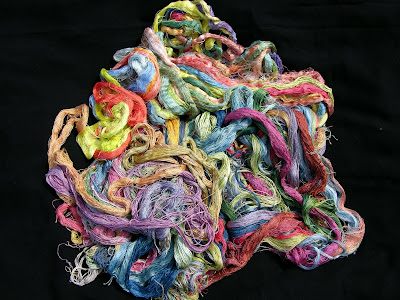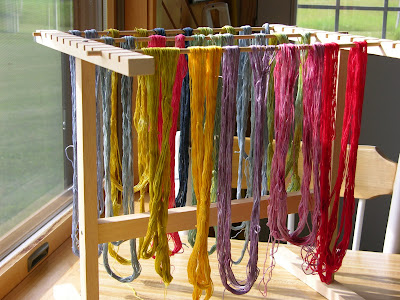Your dye will come from the vendor in small jars of powder. One particularly useful form of MX dye for the beginner is starter kits from
Pro Chemical and Dye.
Look for the "Reactive 6 Dye MX Sampler," for example. This has everything you will need to mix up 8-ounce jars of working solutions in six colors. Another option is the MX Dye Sampler/Cool Primaries or the MX Dye Sampler/Warm Primaries. Each of these has four jars -- the three primary colors and black. All three of these samplers are the same price, $10.95, but the Cool/Warm Primaries samplers have twenty-gram jars of dye and the 6 Dye Sampler jars are ten grams. If you're particularly interested in a range of warm colors, take a look at the "Autumn Blend 6 Dye Sampler:" Turkey Red, Tangerine, Rust Brown, Eggplant . . . These sure look like sampler colors to me.
If you know about or are willing to learn about the color wheel and color mixing you can buy fewer jars of dye and mix the colors yourself. It's easy and fun!
In addition to your dyes, you will need a small bottle of Synthropol, a special textile detergent, and Soda Ash (or, as Pro Chemical calls it, "Dye Activator"). You will find these additives are included in any of the Pro Chemical starter kits described above.
All dyes need to be mixed with care. Dry dye in particular must always be respected. This is what well-known dye scientist Dr. Paula Burch says about dry MX dye:
Be careful when you measure out the dye...leave the jars open as short a time as possible, and use a face mask. Don't breathe dye! The stuff isn't very toxic, but you can become sensitized to it, which would put an end forever to your dyeing.
Her
website is a treasure trove of information and FAQ's about dyeing of all types. Having the wisdom of an expert like this accessible to home dyers is beyond wonderful. The woman is a goddess, I tell you.
Don't work where you'll be distracted; don't work around children. Use a paper dust mask to avoid breathing the dye powder, and wear gloves. Lay down a newspaper under your work, spritz it with water, and any loose dry dye that falls on it will soak in and stay in place. Some dyers set up a cardboard box on its side with the inside spritzed with water, and mix their dyes inside the box.
How I Mix My Dyes
I work in a basement, and I use my laundry tub for this task. I line the tub with newspapers and spray them down with water. I set my 8-oz. canning jars, with about an inch of room-temperature water in each, on the newspaper down in the tub. I set the dye jars down on the newspaper and have plastic spoons at hand. (Note: if you set the plastic spoons down on the wet newspaper, you will introduce moisture into the jars of dye. Leave them standing up in an empty canning jar.)
I open a jar, spoon out a rounded spoonful of dye, empty it into one of the canning jars and screw the lid back on the dye jar. Then I mix the dye in the canning jar around with the spoon, mooshing it against the inside of the jar -- this is called "pasting" the dye -- to force it to absorb the water. I leave the spoon standing in the canning jar and move to the second canning jar, second spoon, and second jar of dye, and repeat the action. When I'm done with all the jars, I pour water into each jar almost to the rim, stirring as I go. The dyes must be completely dissolved at this point. Then I cap the jar and set the spoon aside to be discarded with the newspaper.
Useful information learned the hard way: Remember that you have spoons standing in jars in that sink, and if you move your hands around indiscriminately, you'll hit the spoons and knock over the jars.
When I'm done, I wipe down each closed dye jar and each closed canning jar with wet paper towels as I remove them from the laundry tub. This will insure I'm not bringing dry dye into the room which could escape into the air. Then I bundle the spoons and the paper towels into the newspapers, creating a package to enclose any dry dye that may remain; throw the package away.
At this point what you have is a set of working solutions; these are safe to work with. You won't need a mask, but you will want to wear gloves to keep your hands from being stained.

















